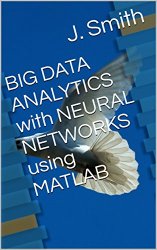BIG DATA ANALYTICS with NEURAL NETWORKS using MATLAB
- Добавил: bhaer
- Дата: 21-03-2017, 01:20
- Комментариев: 0

Название: BIG DATA ANALYTICS with NEURAL NETWORKS using MATLAB
Автор: J. Smith
Издательство: CreateSpace Independent Publishing
Год: 2017
Страниц: 322
Формат: PDF, EPUB
Размер: 14 Mb
Язык: English
Big data analytics is the process of collecting, organizing and analyzing large sets of data (called big data) to discover patterns and other useful information. Big data analytics can help organizations to better understand the information contained within the data and will also help identify the data that is most important to the business and future business decisions. Analysts working with big data basically want the knowledge that comes from analyzing the data.
To analyze such a large volume of data, big data analytics is typically performed using specialized software tools and applications for predictive analytics, data mining, text mining, forecasting and data optimization. Collectively these processes are separate but highly integrated functions of high-performance analytics. Using big data tools and software enables an organization to process extremely large volumes of data that a business has collected to determine which data is relevant and can be analyzed to drive better business decisions in the future. Among all these tools highlights MATLAB.
MATLAB implements various toolboxes for working on big data analytics, such as Statistics Toolbox and Neural Network Toolbox. This book develops Big Data Analytics applications using MATLAB Neural Network Toolboox.
The toolbox includes convolutional neural network and autoencoder deep learning algorithms for image classification and feature learning tasks. To speed up training of large data sets, you can distribute computations and data across multicore processors, GPUs, and computer clusters using Parallel Computing Toolbox.
The more important features are the following:
•Deep learning, including convolutional neural networks and autoencoders
•Parallel computing and GPU support for accelerating training (with Parallel Computing Toolbox)
•Supervised learning algorithms, including multilayer, radial basis, learning vector quantization (LVQ), time-delay, nonlinear autoregressive (NARX), and recurrent neural network (RNN)
•Unsupervised learning algorithms, including self-organizing maps and competitive layers
•Apps for data-fitting, pattern recognition, and clustering
•Preprocessing, postprocessing, and network visualization for improving training efficiency and assessing network performance
•Simulink® blocks for building and evaluating neural networks and for control systems applications
Neural networks are composed of simple elements operating in parallel. These elements are inspired by biological nervous systems. As in nature, the connections between elements largely determine the network function. You can train a neural network to perform a particular function by adjusting the values of the connections (weights) between elements.
Внимание
Уважаемый посетитель, Вы зашли на сайт как незарегистрированный пользователь.
Мы рекомендуем Вам зарегистрироваться либо войти на сайт под своим именем.
Уважаемый посетитель, Вы зашли на сайт как незарегистрированный пользователь.
Мы рекомендуем Вам зарегистрироваться либо войти на сайт под своим именем.
Информация
Посетители, находящиеся в группе Гости, не могут оставлять комментарии к данной публикации.
Посетители, находящиеся в группе Гости, не могут оставлять комментарии к данной публикации.
